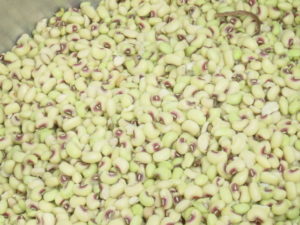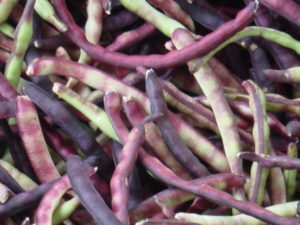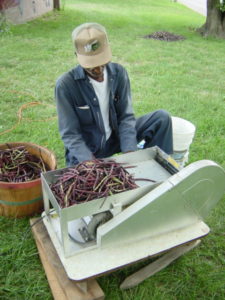Read how this lowly little pea got associated with good luck and try a new recipe using them this New Year.
There are all sorts of superstitions surrounding the start of a New Year—many surround which foods to eat to “guarantee” that the coming year is a good one. The only food my family “has” to eat each New Year is pickled herring thanks to my mom’s Lithuanian heritage. She always checks whether I’ve eaten my herring each New Year, and reminds me that her aunt failed to eat herring one New Year’s Eve and she got in a car accident on New Year’s Day. So there’s your proof the herring is necessary!
A New Year’s tradition that never made it to our house is eating black-eyed peas. This tradition is largely considered to be one belonging to the Southern U.S. Some people feel very strongly that this is a Southern tradition.

Pink-eye purple hull peas, a variation on black-eyed peas.
When I wrote an article many years ago about black eyed peas, a man wrote to me from a Southern state to inform me I had no business as a “Northerner” writing about black-eyed peas. He stopped short of calling me a “damn Yankee, ” but he was not happy.
Though the South claims black-eyed peas as their New Year’s tradition, reportedly the Jews have records in the Talmud of eating black-eyed peas on Rosh Hashanah, the Jewish New Year as far back as about 500 CE. It’s thought that Sephardic and Ashkenazi Jews brought black-eyed peas to the Southern states, and many in these groups were prominent slave owners of the time.
It didn’t take long for black-eyed-peas to become a popular crop in the South. They are extremely heat and drought tolerant, and have few pests and diseases. Add in the fact that they are also a highly nutritious food, and you have about as close to a perfect crop as anyone could hope for.
But why link black-eyed peas with prosperity in the New Year?
- Some point out that dried black-eyed peas look like coins, and they plump up when they are cooked in water, symbolizing prosperity and wealth. And many people associate having a lucky or prosperous year with having lots of money.
- Black-eyed-peas are an inexpensive food. Some sources link their association with luck in the New Year with the saying “Eat poor on New Year’s, eat fat the rest of the year.”
- Other explanations on why black-eyed peas are such a deep-seated New Year’s tradition in the South hinge on events during the Civil War era. When the Union army marched through the South, they destroyed Confederate food sources. Reportedly they left the salted pork and black-eyed peas alone because they thought they were only food for animals. Southerners survived the winter because these foods were spared, and they considered themselves very lucky. So black-eyed peas cooked with pork became a symbol of that luck.
- Other New Year’s traditions link black-eyed-peas to the freeing of African-American slaves since the Emancipation Proclamation made their freedom official on New Year’s day.
There are many ways to cook black-eyed peas on New Year’s Day.
The traditional preparation is to cook them with pork and serve turnip, collard or mustard greens alongside. Some also include cornbread in the meal to ensure more good luck in the New Year. Symbolically, the peas represent copper or coins; the greens are dollars, and the cornbread is gold. Since pigs scoot forward while foraging for food, the pork is said to represent positive motion or progress in the New Year.
There are many variations to the black-eyed pea tradition. Some believe it’s essential to eat 365 black-eyed peas to guarantee good luck on each day of the coming year. Some cooks add a dime to their pot of peas, and the person who finds it will have extra good luck in the New Year.
Another traditional black-eyed pea dish is Hoppin’ John, a mixture of peas, rice, meat, and tomato sauce. Linda Stradley, author of I’ll Have What They’re Having—Legendary Local Cuisine states that food historians believe Hoppin’ John has African/French/Caribbean roots. There are many legends about how the name came about, some involving a man named John, some saying that the dish made people come “a-hoppin’” to the table.
Consider growing your own black-eyed peas this year!

Pink-eye purple hull peas after harvest, ready to be shelled.
Black-eyed peas are a subspecies of cowpeas, and also called crowder peas or southern peas. The black spot or eye on each pea is not always black. It may be purple, pink, red, brown or green. A favorite variation on the black-eyed-pea is the purple hull pea, which as the name suggests has a bright purple hull and the peas inside have a pink or purple eye. People are so fond of this pea there is even a Purple Hull Pea Festival in Emerson, Arkansas.
For a successful crop of black-eyed peas, plant them only after the soil has warmed to over 60°F. Although they can survive extremely dry conditions, they need well-drained fertile soil rather than heavy wet soil. They will improve soil conditions, as they are legumes, and so have root nodules containing bacteria that fix nitrogen or convert nitrogen in the air into a form plants can use. Over time this improves the nutrient profile of the soil.

Shelling peas with an electric sheller
Harvest the peas when they have swelled in the pod and can be shelled, or removed from the pod easily, but before they start to dry naturally on the plant. I learned about picking purple hull peas and shelling them by helping my friend Sonny out in his garden in Decatur, IL. My family never grew purple hull peas before, but Sonny had grown them all his life. They were a staple in his garden just as much as tomatoes and green beans were in mine.
I loved learning about the purple hull peas; my favorite part was putting them through Sonny’s electric sheller. Shelled peas can be eaten fresh or dried for storage. Fresh peas may also be canned or frozen. The green peas that most of us are more familiar with will not work in an electric sheller; they would turn to mush. The purple hull peas are much harder, and they have to be cooked differently as well.
I remember when I asked Sonny about cooking purple hull peas and he looked at me like I was nuts. He asked, “What’s a white girl want to know about soul food for?” While it sounds pretty blunt, he was just being honest. A dish so familiar in his family was completely foreign to mine. He sent me home that day with a bag of shelled peas and instructions on how to simmer them with a smoked ham hock or bacon. My peas were not nearly as good as anything Sonny cooks up; this white girl has a lot to learn about proper cooking of soul food! But I sure do love growing gardens and how the food produced there connects us all, whether we know about soul food or not.
Have I replaced the pickled herring with black-eyed peas? Not yet. But I am going to incorporate black-eyed peas in our New Year’s menu in this unique twist on hummus:
Black-eyed Pea Hummus
3 Garlic cloves, peeled
1/2 Cup Lemon juice (or juice from 2 lemons)
1/3 Cup Tahini (sesame-seed paste)– I found it near the olive oil at our grocery store
2 Tablespoons Olive oil
1 teaspoon Ground cumin
1/2 teaspoon Salt
3/4 teaspoon Paprika
2 (15.8-ounce) Cans black-eyed peas, drained
14 (6-inch) Pitas, quartered or raw vegetables to dip
Combine all ingredients. Use a food processor or blender to process until smooth. Serve with pita wedges or raw vegetables. Refrigerate leftovers.
Have you subscribed to Grounded and Growing?
If you liked this post, please subscribe to Grounded and Growing today and receive your copy of “15 Tips to Become a '15 Minute Gardener'” so you can spend less time working ON your garden and more time enjoying being IN your garden.! It’s absolutely free. When you join the Grounded and Growing community, you’ll finally take the garden off your “To-Do” list and allow yourself time to enjoy your garden and savor the peace and serenity there. I tell subscribers about new posts as soon as I hit ‘publish’ and send weekly-ish updates on what’s going on in my garden– good, bad AND ugly.
My mom used to make ham and beans with cornbread every year for good luck. Since she lives in an assisted living, she no longer can. I really miss this tradition, but neither one of my kids or grandkids like them, so I need to come up with a new tradition! I don’t think the pickled herring would go over too well either! Thanks for bringing back the memories!
Well, no one in my house eats the pickled herring except me! I made the black-eyed pea hummus on New Year’s Day and it was a hit! Everyone loved it, even the little guy. That might be a way to sneak them in.